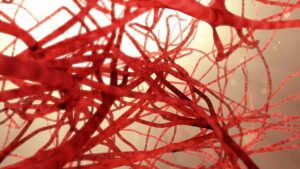 Your veins play an integral role in your body. Small tubes run throughout the body to carry deoxygenated blood back to your heart to be re-oxygenated and pumped back out to keep your tissue and organs healthy.
Your veins play an integral role in your body. Small tubes run throughout the body to carry deoxygenated blood back to your heart to be re-oxygenated and pumped back out to keep your tissue and organs healthy.
It’s reported that the human body has over 60,000 miles worth of blood vessels, which is there total of your combined veins and arteries. Veins and arteries differ in their purpose: whereas veins carry blood back to the heart, arteries carry oxygenated blood away from the heart to be distributed.
Advertisement
This is the process by which your tissue and organs receive oxygen, nutrients, and the fuel they need to keep you alive.
But what do healthy veins look like?
Veins are colorless, but it’s not uncommon to see them on your hands, arms, or other areas where the skin is thin. They may have a slight bulge and appear slightly purple, blue, or green.
Those colors, in fact, are not your veins at all. The color is simply the blood that’s flowing through them.
If they look a bit blue or purple, don’t worry about it. However, if they suddenly begin to bulge or become a dark color, talk to your doctor because it may signify an underlying condition.
It cools also be a symptom of common conditions like varicose or spider veins.
Varicose veins are veins that have become swollen and twisted. They typically take on a purplish or bluish color and bulge more than regular veins.
They happen when there is increased pressure in the vein, causing damage. The valves in the vein can stop working, limiting the movement of blood. It pools and stretches the vein, creating visible bulges or “knots.”
Varicose veins are not typically dangerous. However, they can occasionally indicate underlying conditions or develop uncommon complications.
Spider veins are another common venous condition. They are damaged veins that appear just under the skin, looking like small red or purple threads. They are much thinner and closer to the skin than varicose veins. These veins are generally without harm, as well.
Are there ways to keep your veins as healthy as possible? You bet. Encouraging healthy veins is likely easier than you might think.
Here are some things to do:
Drink plenty of water: Water helps thin blood so it flows more easily. When blood is thinner, it’s easier for ovens to carry it back to the heart.
Advertisement
Elevate your feet: Putting your feet up a few times per day for five minutes can help improve circulation, reduce swelling, and relieve pressure on your legs.
Walk: Walking is one of the most efficient strategies to improve circulation and vein health.
Eat well: Fruits and vegetables, particularly those rich in vitamins C and K, can aid vein health. Try to limit your intake of salt, as well as sugary and processed foods.
